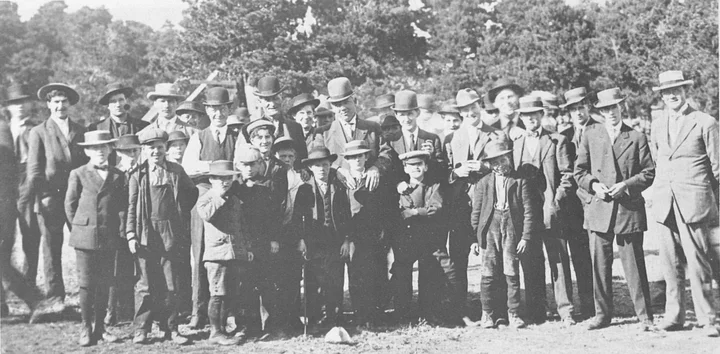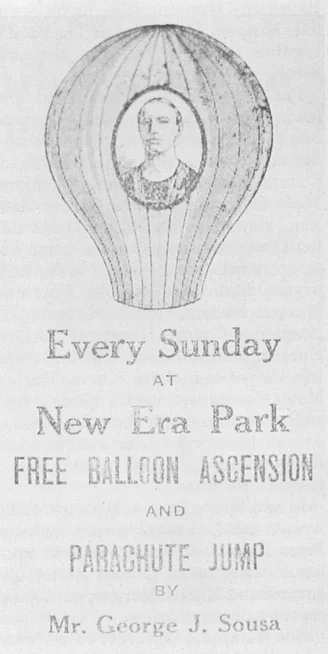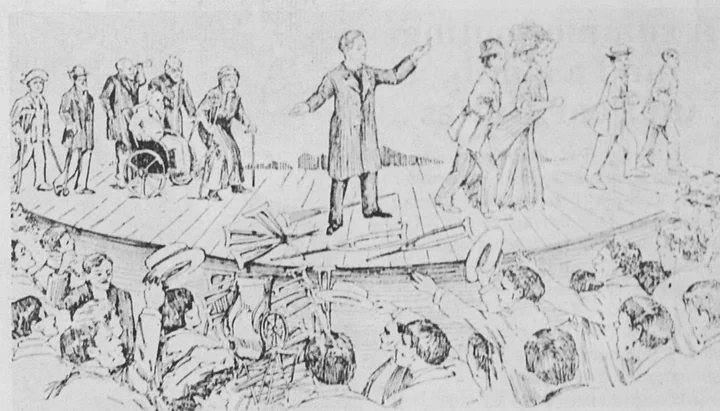The Great Fer-Don, wearing a derby hat, is shown in center of this picture with his hands on the shoulders of a boy. This was part of a crowd he attracted to New Era Park on August 30, 1908.
###
From the beginning, the people of Humboldt County had to create much of their own entertainment.
On the Fourth of July, they would load an anvil with black powder and set it off to produce a very loud explosion. Another sport was a tug-of-war in which one team of loggers would pull on a long rope against another team and when the center marker was pulled across a line the winners took all. There were the hose cart races put on by various volunteer fire companies, band concerts at Sequoia Park and New Era Park, picnics held by clubs and organizations and many dances for such occasions as new house-warmings, barn-raisings or shivarees for newlyweds. And, of course, there was always swimming at the old Sand Banks at Ryan’s Slough and the mouth of Elk River. In addition, there was always boating on Humboldt Bay.
There were many beautiful parades staged for each holiday, and there were all kinds of stunts performed to entertain. Various groups put on shows and vaudeville acts.
One day a daring fellow walked a tightrope stretched between the roofs of the Humboldt County Bank on the southeast corner of Second and G streets and the Vance House on the northwest corner. This was an exciting event. During these days there were traveling peddlers, photographers, gypsies, medicine men, preachers, musicians, circuses, and tin-ware peddlers called “sheenies.” These people traveled throughout the United States, probably more in the southern and eastern states. However, when our roads improved, a few did manage to tour this remote section of California.
In the year 1908, there were several such persons in Humboldt County during the summer months. One was a balloonist and parachutist, George Sousa. He would fill his balloon with hot air and smoke, and go up every Sunday, weather permitting. He started his operation from New Era Park, located near Fairhaven on the north peninsula of Humboldt Bay. Here he would spread out his balloon and build a smoking fire. The smoke and heat would be piped under the balloon, and this would gradually fill the big bag which was securely tied down until ready for flight. There would always be a large crowd to watch as Sousa climbed into his basket suspended under the balloon. He would holler and some helpers would release the lines and up he would go. When he reached a certain altitude, he would jump out opening his parachute and start down, hoping he would not land in the bay.
One Sunday, Sousa took a small dog up with him and the pooch was dropped with the aid of a parachute. The dog made it all right, but some people did not like this action, feeling it was “cruelty to animals.” Sousa always made safe flights and jumps in Humboldt County, but he was later killed when his parachute failed to open. This accident occurred in the southern part of the state and was quite a sensational news item in those days.
There was always some form of entertainment going on at New Era Park. An expert bicyclist, Court Edwards, did sensational tricks and stunts on his bicycle. There was another attraction at this same time at the Park. A daring fellow. Captain McLean, came with his new diving outfit (this was the old fashion kind with the heavy diving bell and required that air be pumped to the diver at all times). He would walk into Humboldt Bay for quite a distance, bringing up crabs and clams, much to the amazement of all the spectators. This event was held on Sundays and was well attended.
Hundreds of people would take their picnic lunches and go down to the foot of F Street and get on a launch at Wilkinson’s Launch Co. (this was before Cogshell Co. operated vessels). This would be a pleasant ride across the bay to the park, especially on a nice sunny day. The children would wade in the surf, some would swim and some would play in the sand. Others would build sand castles, pick up pretty shells and stones and sand strawberries that grew all over the sand dunes. The older folks would gather driftwood and build a fire, spread a blanket or tarp and there would be weenie roasts. We were sorry when time came to board the launch and head for home.
Also, I must mention that some of the braver ones would, at low tide, climb on the decks of the old Milwaukee wreck (this was in the latter days of 1918-19). I remember the worst sunburn I ever had while out there.
###
Drawing in newspaper advertisement showed Fer-Don healing the sick and the crippled.
The main part of this story is about one of those persons who traveled all over the country with a small wagon especially built for light delivery, like mail carriers and laundry wagons. It was pulled by a single horse or mule. If it was a heavy wagon, there would be a team of horses. This particular man arrived in Eureka on August 3,1908. He was well advertised and much talked about and called “Patent Medicine Fakier, the World’s Great Fer-Don.” He moved into town with his horses and colorful wagons, all painted up to draw as much attention as possible to his show. He and his crew set up a giant tent on the corner of Fourth and I streets. Also, he opened an office in the Week Building at 311 F Street, and here his “European medical experts” worked their trade during the day.
Meanwhile, the Eureka City Council decided on a $50 per day license fee, which did not seem to bother the Great Fer-Don. He started his operation by staging a giant parade with all of his people, including his Great Diamond Cluster Band. The band was composed of several good musicians. The parade would circle around town for a couple of hours, finally ending up at his large tent. It reminded one of a circus or carnival day to see the large crowds assembled to hear and see the Great Fer-Don on opening night. He amused himself by throwing handfuls of silver coins into the excited throng. None but the Great Fer-Don knew how much money he threw away, but a bank cashier estimated the amount to be several hundred dollars. It was also estimated by a newspaperman that fully 10,000 people were there.
Fer-Don was an unusual character, and reports from other cities he had visited indicated that he had always been liberal with his money, especially among the poor and destitute. It was rumored around Eureka that Fer-Don had visited many poor families and distributed his charity among them. The Great Fer-Don was the talk of the town in nearly every home, barbershop, store and office. Each night, on a large platform at the free-show grounds, he treated the lame, the rheumatic and the deaf. Some asked if the cures were permanent. The press reported the case of Ed Knapp of Bucksport, who had been deaf in his right ear for ten years. One night during the show he was made to hear and many people said it would not last, but Knapp’s hearing remained at a normal level.
Fer-Don said to a reporter, “There are ten thousand testimonials on file in the main office in San Francisco. People from all over the states of California, Arizona, Nevada and Utah all claim to have been greatly benefited or cured by these methods and there will be some cured right here in Eureka.”
Max Hanker of 1835 Second St., Eureka, told his story. He said he had a large tumor on the back of his head. The Great Fer-Don had his European medical experts apply a preparation to the head of Hanker and, according to Hanker, this dissolved the outer covering of the tumor and inside of a very few minutes the entire growth was gone. He said no knife was used, there was no pain and no blood. It was reported that many saw and marveled at the way the cure was accomplished. Many of the skeptical came for the entertainment, saying the operation could not be performed painlessly and bloodlessly as had been promised. It was reported that these left satisfied that the Great Fer-Don had known whereof he spoke in claiming his staff could conquer disease, remove tumors, cancers, and gallstones without operations.
The press reported that “crowds of humanity are now calling at the offices of the European medical experts in the Week Building, 311 F Street. Many people are taking advantage to see and test the bloodless surgeon’s methods of curing the sick.”
During an interview Fer-Don said that many people asked him personally if he would examine and treat them and his answer was always, postively, “No, the European medical experts do all the treating. I do nothing but attend to managing the staff of doctors and delivering the lectures. I don’t profess to be a doctor or hold myself out as such.”
When the Great Fer-Don first came to Eureka he told the people that the European medical experts would work miracles and he claimed their method in healing the sick was unknown to other physicians. He boasted proof of how well FerDon kept his word, saying, “Hundreds of our most prominent citizens have tested their skill.” Fer-Don said he had on file, here in his office, hundreds of testimonials from people who lived in Eureka.
His advertisements said:
Each week, standing out boldly from amidst failure of others, he publishes the names and addresses of people cured in this community; people whose standing forbids the thought of their lending their names to say but an honest statement. The people ask themselves, what does this mean? And the answer impresses itself upon them with a force of complete conviction.
Nothing but merit and real conscientious work could produce such results and make such a record as this. Go to see these people, have a talk with them. They do not live 1,000 miles away, but are right here where they can be seen and have their truthful statements verified.
Miss Metsala, living at the Revere Hotel, in Eureka, called at the office of the European experts to thank them for curing her and saving her life. The young woman was suffering from gallstones and had as usual failed to get any relief. She had suffered greatly for months with attacks. Doctors who had been attending the case said the only hope of relief was an operation. She heard of the wonderful cures for gallstones by the European medical experts now visiting Eureka.
Miss Metsala called at the office at 311 F Street and the European doctor gave her three doses of their medicine and in less than 16 hours time, hundreds of gallstones were removed from her system, some as large as cherries. In speaking to a reporter. Miss Metsala said, “I am so happy as all doctors told me I never could get well without an operation. But just think — I was cured without the use of a knife and no pain whatever.”
…There are many testimonials like this here in Eureka, too numerous to mention.
The Great Fer-Don liked little children, and he was always giving something to them wherever he went. On Saturday, August 8, 1908, he invited all Eureka children to attend a free theatre party at a local showhouse. He would often rub some of his patent medicine on a small boy’s head and ears, saying it would make him grow to be big and strong. The Great Fer-Don had his own minstrel show, with several very fine black singers. In addition, he had a couple of clowns and tumblers. Fer-Don was a magician and a skilled speaker. He could hold an audience spellbound with his gift of speech, and he could sell anything, including his magic potion at the awful price of $1 per bottle.
Fer-Don would be at New Era Park every Sunday with his wonderful Diamond Cluster Band, where they would play a concert for the crowd. Selections included, March Chorale Overture, Poet and Peasant, Waltz Sweet Remembrance, Cornet Solo, Polka Impromptu, Flower Girl, Intermezzo, Grand Fantasia, March by Sousa and other numbers. These concerts were enjoyed by a great many people and are still remembered by some of the old timers.
The Great Fer-Don remained here in Eureka until September 2, 1908. He then took down his huge tent, loaded up his wagons and headed south.
And that’s the way it was.
###
The story above was originally printed in the March-April 1986 issue of The Humboldt Historian, a journal of the Humboldt County Historical Society, and is reprinted here with permission. The Humboldt County Historical Society is a nonprofit organization devoted to archiving, preserving and sharing Humboldt County’s rich history. You can become a member and receive a year’s worth of new issues of The Humboldt Historian at this link.




CLICK TO MANAGE